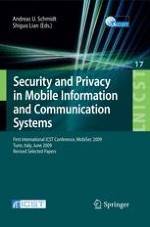MobiSec 2009 was the first ICST conference on security and privacy in mobile information and communication systems. With the the vast area of mobile technology research and application, the intention behind the creation of MobiSec was to make a small, but unique contribution to build a bridge between top-level research and large scale application of novel kinds of information security for mobile devices and communication.
The papers at MobiSec 2009 dealt with a broad variety of subjects ranging from issues of trust in and security of mobile devices and embedded hardware security, over efficient cryptography for resource-restricted platforms, to advanced applications such as wireless sensor networks, user authentication, and privacy in an environment of autonomously communicating objects. With hindsight a leitmotif emerged from these contributions, which corrobarated the idea behind MobiSec; a set of powerful tools have been created in various branches of the security discipline, which await combined application to build trust and security into mobile (that is, all future) networks, autonomous and personal devices, and pervasive applications
